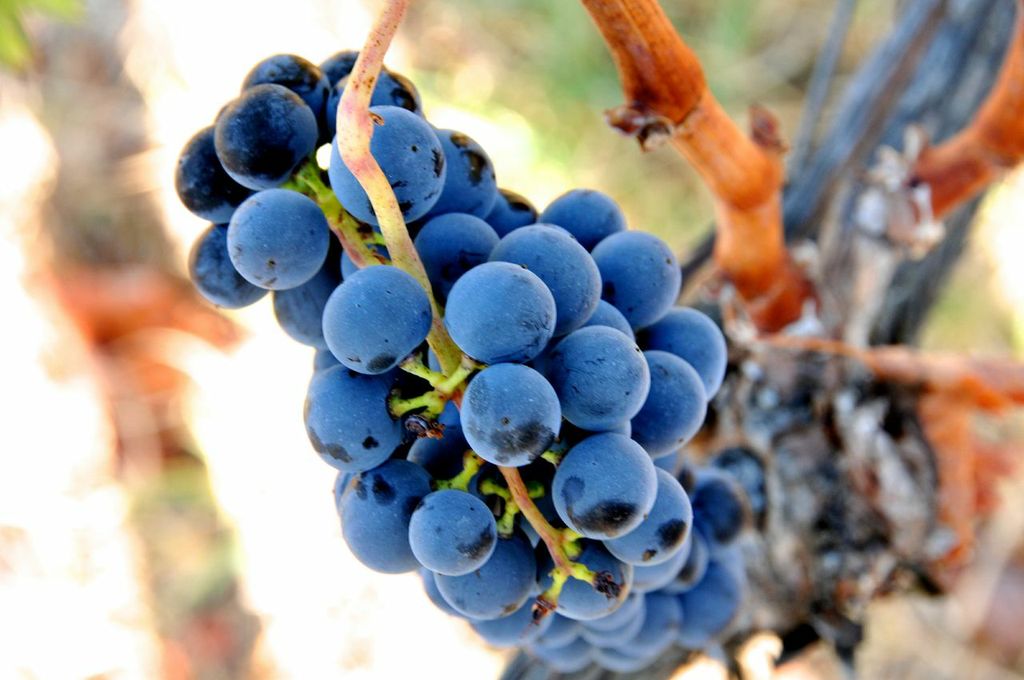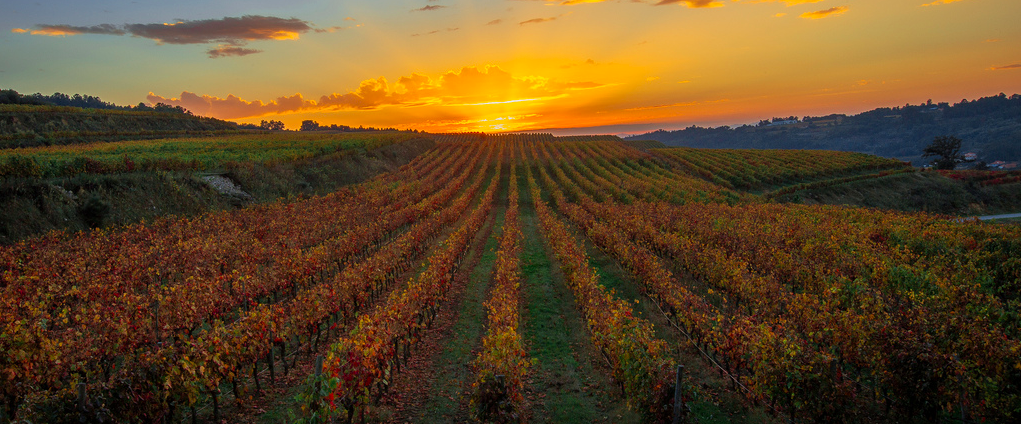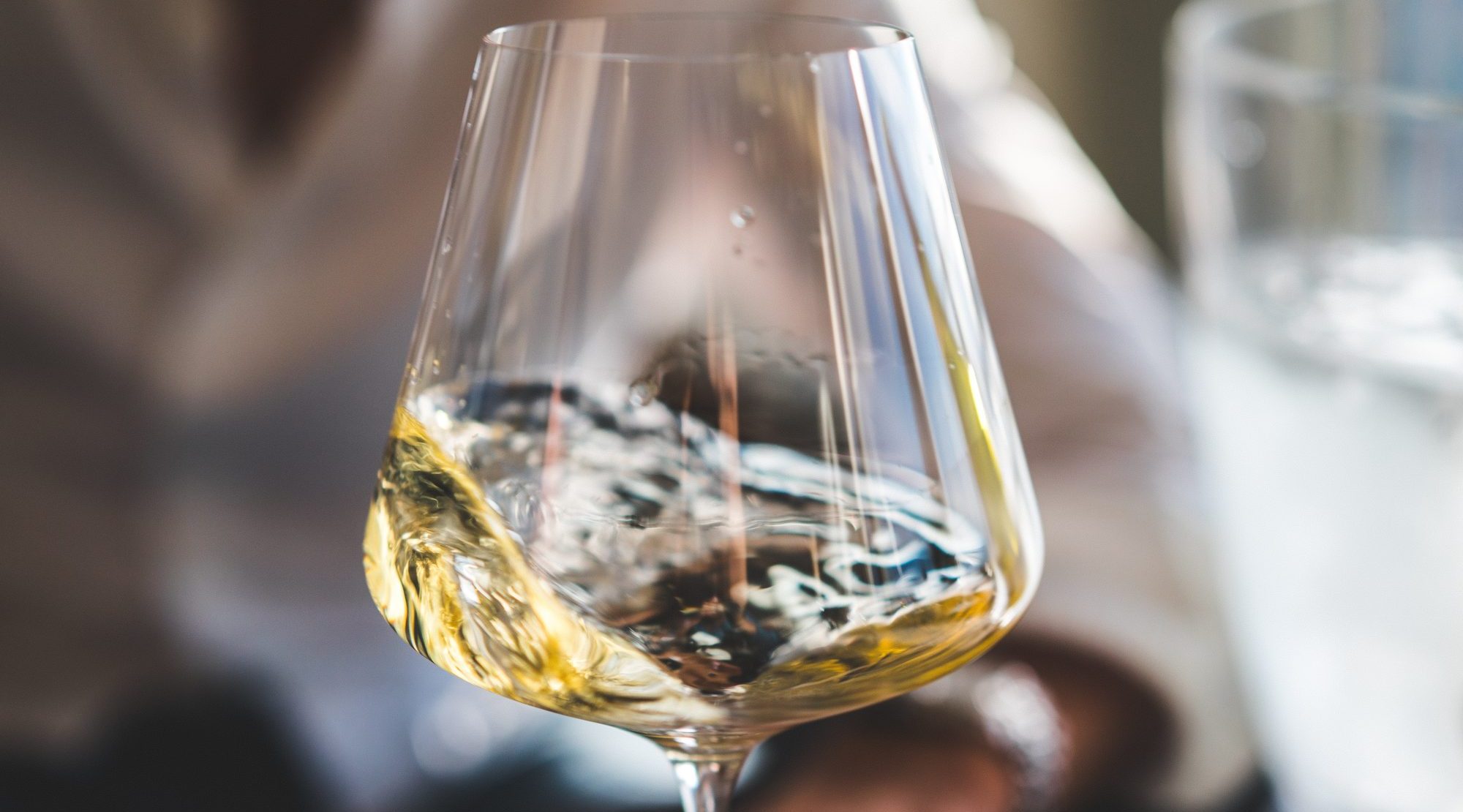Discovering Dão Wines: The Burgundy of Portugal

It was a cool Lisbon summer night with a near-full moon, a breeze coming in from the Tagus River and friends coming over for dinner, life felt pretty good. Dinner parties happen to be one of my favorite pastimes, and Pete and I tend to make a solid team when it comes to hosting them (he feels strongly about the food, I like to pick the wine, we pick the tunes together).
That said, our guests happened to be huge foodies and very wine savvy, which meant that we needed to up our game! Confident in our grilled salmon steaks, fresh from the market in Cais do Sodré, we dove into the wine. What do you choose for boutique winery types who’ve tried everything?
I went for one of my Go-To whites. It’s the kind of wine I’d confidently open over a meal with my in-laws or with any wine aficionado. Seeing it on a wine list always makes me smile as if I’ve just run into a dear friend after years of separation. It’s the kind of wine you could gift your boss, assuming you don’t want to drink it yourself. Definitely the kind of wine to drink over a candle-lit dinner when you’re trying to impress. Pete and I like it so much that we served it on our wedding day, and we continue to delight in drinking the extra cases we’re still hoarding. The more we get to know it, the more of a Go-To it becomes.
Wait, wine from where? This might be your reaction if you’re just getting to know Portuguese wines, although anyone familiar with the Portuguese wine scene will know the region. Not to worry – more on the Dão in the coming paragraphs. Read on!

So back to our dinner party. I put a bottle of Quinta das Marias 2011 Encruzado in the fridge mid-afternoon, and it was perfectly chilled by the time our guests arrived….an hour and twenty minutes late. Which, to be fair, actually qualifies as being on time in Portugal.
The four of us sat outside by the charcoal barbecue, each with a glass of the Encruzado in hand. Steely, citrus aromas wafted up from my glass as I sat back and took in the evening. There was nothing flaky about this wine. It felt perfectly capable of supporting a heartfelt conversation about family strife and elegant enough to know when to keep your opinions to yourself in light of the evening. It doesn’t get much better.
As we roasted peppers and grilled fish over the charcoal, the conversation flowed to the wines of the Dão. We unanimously agreed that these were not only under-appreciated but that they were undoubtedly the Audrey Hepburn of wines – elegance with grace. Our friends rightfully coined it, “The Burgundy of Portugal.”
Coincidentally, a family commitment took me to the Dão not a week later, where I had the pleasure of exploring a significant number of wineries and their wines. So let’s dive into what makes this region absolutely worth your time!
The Dão Region
The Dão region is located in the northern part of central Portugal. The drive to Dão from Lisbon took us about three hours, although legend has it some manage to make the trip in two and a half. The region is located on a plateau, and you can see and feel that you’re at a distance from sea level. As we approached the Dão, my ears began to pop and the temperature dropped. We were surrounded by the Serra da Estrela, Serra do Caramulo, and Serra da Nave mountain ranges, which shelter the Dão from the Atlantic Ocean to the west. I learned that these mountains are granitic, and for this reason, you’ll find granitic soils in many of the Dão’s vineyards, lending to more mineral wines.

Dão Reds
It’s our first night in the Dão, and we have dinner at Santa Luzia, a widely recommended local restaurant. It was cold and raining outside, but inside the modernly-decorated restaurant, it was light and spacious. We’d ordered mostly heavy, meat-based dishes (except for my sister-in-law, who is a vegetarian – though options for Portuguese vegetarian options do exist!). We decide on red, which is appropriate, as red wines make up 80% of the region’s production.
The waiter brings us a bottle of Quinta de Lemos Alfrocheiro, a beautiful monovarietal Dão wine with 14.4% alcohol! Normally, I’d shy away from such percentages, but in this case, the wine was so balanced, the acidity and tannins so well-integrated, that I fell in love. It underscored the reputation that Dão wines can have for making concentrated, tannic, yet elegant and restrained wines.
Other than Alfrocheiro, hallmark grape varieties include Touriga Nacional, Tinta Roriz (known in Spain as Tempranillo) and Jaen (known in Spain as Mencia). You may have heard of Touriga Nacional – it’s often a key ingredient in Port wine blends. Decanter Magazine has described the grape as Portugal’s “hero.” And while Touriga Nacional grows in vineyards across the country, Dão locals will proudly say that the grape finds its best expression in the Dão, the region it calls home. For a Touriga Nacional – based example to drink at home, splurge on a bottle of Quinta dos Carvalhais Touriga Nacional or a Julia Kemper Curiosity.
Dão Whites
I started this piece by gushing about Quinta das Marias Encruzado, so you can imagine I was happy to be in its “hometown.”
The Dão’s minority white wine production may be small when compared to the red, but it’s equally distinguished.
Dão whites will often be blends that include Malvasia Fina and Bical, a wickedly good combination when done well! We drank a special one over lunch – the Casa de Santar Branco Reserva, which went incredibly well with the cabrito assado (roasted goat) that Pete and his brother ordered and was a good match for Megan’s vegetable stew and my octopus salad. Then again, you could have thrown in an entire cow…raw…and garnish in foie gras…and I’d still love this wine!
Blends may be the region’s bread-and-butter white wine, but the Dão is perhaps best known for the Encruzado grape. Encruzado may be renowned for its crisp citrus flavors and aromas and refreshing acidity, but in my view, the best examples stand out for their distinct mineral characteristics and delicate floral character; and might even be slightly oily or resinous on the palate. Pick up a bottle of Quinta da Cabriz Encruzado for a well-priced, everyday drinking example of this grape variety; and get your hands on Quinta dos Roques Encruzado for an absolute treat.

Make Room in Your Cellar
It is said that Dão wines can have outstanding aging potential. With their strong tannic backbone and healthy doses of acidity, the region’s reds make some excellent candidates for cellaring. Similarly, the acidity profile that characterizes many of the whites can make very age-worthy wines. Jancis Robinson attests that producers in the Dão are making wine with “no lack of aging potential and interest.” And we’re not just talking red.
I mentioned that I’m still hoarding some 2011 Quinta das Marias Encruzado from our wedding day, and I’m doing my best to keep these bottles stashed away in our cellar. The wine is drinking beautifully now, but I absolutely feel confident that it’ll continue to develop in bottle. In fact, I was recently thrilled to be at a tasting and learn that their white wines from the late 1990s are in excellent drinking condition.
Hidden Gems
I continue to be surprised by Dão’s relative lack of proliferation in markets like the U.S. As ‘the Burgundy of Portugal’ would suggest, the Dão is widely recognized in Portuguese circles as a top wine region. And while Portugal has been the beneficiary of significant press internationally, the Douro has been getting the bulk of the attention overseas. It’s no secret that Dão wines have a strong Portuguese following, but I see the potential for a much broader fan base. So what’s behind Dão wines’ relative low-profile overseas?
Turns out there are some sensible explanations. I learned a bit about the Dão’s history during my recent weekend there. While it’s one of Portugal’s oldest wine regions, winemaking suffered for decades from stifling government controls. Dictator Antonio Salazar granted cooperatives the exclusive right to make wines in the region. This killed competition amongst winemakers, leading to years and years of inferior quality, flat wines produced with old-fashioned methods. Wine production in the Dão stagnated until 1979, when Salazar’s restrictions were lifted upon Portugal’s application to join the EU. The past 35 years have witnessed a true transformation in Dão winemaking, so the region is still making a name for itself.
Also, the Dão is small, and land ownership is fragmented. The average vineyard plot size is smaller than half a hectare. To put this into context, the grassy area inside of a 400 meter track is over twice the size of the average Dão vineyard. You can imagine that small landowners would have a difficult time commercializing their wine, especially in international markets.
Nonetheless, the Dão is more and more the subject of international recognition.
If you’re interested in exploring Dao, diving deep into their gastronomy and culture, let us know! We’d love to guide you through one of our favorite wine regions in Portugal!






